ADM 2320Q Chapter 10 PDF

| Title | ADM 2320Q Chapter 10 |
|---|---|
| Course | Marketing |
| Institution | University of Ottawa |
| Pages | 12 |
| File Size | 278.2 KB |
| File Type | |
| Total Downloads | 81 |
| Total Views | 174 |
Summary
Chapter 10 notes from the textbook for Professor Vessela Zaykova's class...
Description
-
A service is any intangible offering that involves a deed, performance, or effort that can't be physically possessed, customer service specifically refers to human or mechanical activities that firms undertake to help satisfy their customers needs and wants. By providing good customer service, firms add value to their products or services
-
Economies of developed countries such as Canada have become increasingly dependent on services. For example, the service sector makes up more than 70 percent of Canada’s economy.
-
This dependence and the growth of service-oriented economies in developed countries have emerged for several reasons
-
First, it is generally less expensive for firms to manufacture their products in less developed countries.
-
Second, household maintenance activities, which many people performed by themselves in the past, have become quite specialized.
-
Third, people place a high value on convenience and leisure
SERVICES MARKETING DIFFERS FROM PRODUCT MARKETING:
-
The marketing of services differs from product marketing because of four fundamental differences unique to services: they are intangible, inseparable, variable, and perishable.
Intangible: -
As the title of this chapter implies, the most fundamental difference between products and services is that services are intangible; they cannot be touched, tasted, or seen like a pure product can.
-
This intangibility can prove highly challenging to marketers. For instance, it makes it difficult to convey the benefits of services
-
Furthermore, a service is also difficult to promote because it can’t be shown directly to potential customers. Marketers must therefore creatively employ symbols and images to promote and sell services,
-
Because of the intangibility of services, the images marketers use reinforce the benefit or value that a service provides.
Inseparable Production and Consumption: -
Services are produced and consumed at the same time—that is, service and consumption are inseparable. Because service production can’t be separated from consumption, astute service marketers provide opportunities for their customers to get directly involved in the service.
-
Because the service is inseparable from its consumption, customers rarely have the opportunity to try the service before they purchase it. And after the service has been performed, it can’t be returned
-
Because the purchase risk in these scenarios can be relatively high, services sometimes provide extended warranties and 100 percent satisfaction guarantees
Inconsistent: -
The more humans that are needed to provide a service, the more likely that the service’s quality will be inconsistent or variable
-
But an inferior service can’t be recalled; by the time the firm recognizes a problem, the damage has been done. Some marketers of services strive to reduce service inconsistency through training and standardization.
-
Marketers also can use the inconsistent nature of services to their advantage. A micromarketing segmentation strategy can customize a service to meet customers’ needs exactly
-
Such micromarketing can be expensive to deliver though, particularly for a firm that offers multiple services. Consumers also may get confused or even irritated if they must pay for each little service
-
In an alternative approach, some service providers tackle the inconsistency issue by replacing people with machines
-
Self-checkouts can be successful and increase customer loyalty, because they appeal to shoppers who want to move quickly and believe they can zip through checkouts faster by using the machines. Although expensive, the machines reduce labour costs; one cashier can oversee the operation of four to eight self-checkouts. And the machines don’t have to be trained—nor do they ever come to work late or with a bad attitude, thereby reducing service inconsistency.
-
The technological delivery of services sometimes causes additional problems. Customers may not embrace the idea of replacing a human with a machine for business interactions or have problems using the technology. In addition, the technology may not perform adequately
-
The Internet has reduced service inconsistency in several areas. Customers can purchase travel items (e.g., airline tickets, hotel rooms, rental cars), concert and movie tickets, insurance, mortgages, and merchandise directly via the Internet or by cellphone
-
Beyond online benefits, the Internet has also reduced service inconsistency
Inventory: -
Services are perishable because they cannot be held in inventory or stored for use in the future. The perishability of services provides both challenges and opportunities to marketers in terms of the critical task of matching demand and supply. As long as the demand for and the supply of the service match closely, there is no problem; but, unfortunately, this perfect matching rarely occurs
-
Balancing the ups and downs of demand and capacity is challenging. For services companies, excess demand results in having to turn customers away in peak periods, while excess capacity may mean less desirable expense to revenue ratios
PROVIDING GREAT SERVICE: THE GAPS MODEL -
We now examine what is known as the Gaps model, which is designed to highlight those areas where customers believe they are getting less or poorer services than they expect (the gaps) and how these gaps can be closed.
-
Customers have certain expectations about how a service should be delivered. When the delivery of that service fails to meet those expectations, a service gap results
-
The knowledge gap reflects the difference between customers’ expectations and the firm’s perception of those customer expectations. Firms can close this gap by matching customer expectations with actual service through research.
-
The standards gap pertains to the difference between the firm’s perceptions of customers’ expectations and the service standards it sets. Firms can narrow this gap by setting appropriate service standards and measuring service performance.
-
The delivery gap is the difference between the firm’s service standards and the actual service it provides to customers. This gap can be closed by getting employees to meet or exceed service standards
-
The communication gap refers to the difference between the actual service provided to customers and the service that the firm’s promotion program promises. Generally firms can close this gap if they are more realistic about the services they can provide and manage customer expectations effectively.
The Knowledge Gap: Knowing What Customers Want -
An important early step in providing good service is knowing what the customer wants
-
To reduce the knowledge gap, firms must understand the customers’ expectations, which can be accomplished through customer research and by increasing the interaction and communication between managers and employees.
Understanding Customer Expectations: - Customers’ expectations are based on their knowledge and experiences. Expectations vary according to the type of service, people’s expectations also vary depending on the situation Evaluating Service Quality by Using Well-Established Marketing Metrics: - To meet or exceed customers’ expectations, marketers must determine what those expectations are. Yet because of their intangibility, the service quality, or customers’ perceptions of how well a service meets or exceeds their expectations, often is difficult for customers to evaluate -
Customers generally use five distinct service dimensions to determine overall service quality: reliability, responsiveness, assurance, empathy, and tangibles
-
Marketing research provides a means to better understand consumers’ service expectations and their perceptions of service quality. This research can be extensive and expensive, or it can be integrated into a firm’s everyday interactions with customers.
-
A systematic voice-of-customer (VOC) program collects customer insights and intelligence to influence and drive business decisions
-
An important marketing metric to evaluate how well firms perform on the five service quality dimensions the concept of the zone of tolerance refers to the area between customers’ expectations regarding their desired service and the minimum level of acceptable service—that is, the difference between what the customer really wants and what he or she will accept before going elsewhere.
● the desired and expected level of service for each dimension, from low to high ● customers’ perceptions of how well the focal service performs and how well a competitive service performs, from low to high ● the importance of each service quality dimension -
A very straightforward and inexpensive method of collecting consumers’ perceptions of service quality is to gather them at the time of the sale. Service providers can ask customers how they liked the service—though customers often are hesitant to provide negative feedback directly to the person who provided the service—or distribute a simple questionnaire
-
Furthermore, in some cases, customers cannot effectively evaluate the service until several days or weeks later
-
Another excellent method for assessing customers’ expectations is making effective use of customer-complaint behaviour. Even if complaints are handled effectively to solve customers’ problems, the essence of the complaint is too often lost on managers
The Standards Gap: Setting Service Standards Achieving Service Goals Through Training: - To deliver consistently high-quality service, firms must set specific, measurable goals based on customers’ expectations; to help ensure that quality, the employees should be involved in the goal setting -
While front-line service employees can be taught specific tasks related to their jobs, it is simply not enough to tell employees to “be nice” or “do what customers want.” A quality goal should be specific, in extreme cases, such training becomes even more crucial
Commitment to Service Quality: - Service providers take their cues from management. If managers strive for excellent service, treat their customers well, and demand the same attitudes from everyone in the organization, it is likely employees will do the same. -
Employees who understand that operating on time is a critical component to service quality and guest experience work hard to improve on-time performance
-
Sales agents also strive to provide the highest standard of customer service
The Delivery Gap: Delivering Service Quality -
The delivery gap is where “the rubber meets the road,” where the customer directly interacts with the service provider. Even if there are no other gaps, a delivery gap always results in a service failure
-
Delivery gaps can be reduced when employees are empowered to act in the customers’ and the firm’s best interests and are supported in their efforts so they can do their jobs effectively. Technology can also be employed to reduce delivery gaps
Empowering Service Providers: - In this context, empowerment means allowing employees to make decisions about how service is provided to customers. When front-line employees are authorized to make decisions to help their customers, service quality generally improves -
However, empowering service providers can be difficult and costly. In cases in which the service is very repetitive and routine
-
Empowerment becomes more important when price points edge higher and services are more individualized
Providing Support and Incentives: - A service provider’s job can often be difficult, especially when customers are unpleasant or less than reasonable
-
First, managers and coworkers should provide emotional support to service providers by demonstrating a concern for their well-being and by standing behind their decisions.
-
Second, service providers require instrumental support—the systems and equipment to deliver the service properly. Many retailers provide state-of-the-art instrumental support for their service providers
-
Third, the support that managers provide must be consistent and coherent throughout the organization
-
Finally, a key part of any customer service program is providing rewards to employees for excellent service.
Using Technology: - Technology has become an increasingly important method for facilitating the delivery of services, firms have invested heavily in technologies that have enabled customers to buy more quickly, more easily, and with more information than in the past -
Web-enabled services have also changed the way firms do business
-
Using technology to facilitate service delivery can provide many benefits, such as access to a wider variety of services, a greater degree of control by the customer over the services, and the ability to obtain information. Management also benefits from the increased efficiency in service processes through reduced servicing costs and, in some cases, can develop a competitive advantage over less service-oriented competitors. Technological advances that help close the delivery gap are expanding
The Communication Gap: Communicating the Service Promise -
Poor communication between marketers and their customers can result in a mismatch between an ad campaign’s or a salesperson’s promises and the service the firm can actually offer. Although firms have difficulty controlling service quality because it can vary from day to day and from provider to provider, they have nearly constant control over how they communicate their service package to their customers. This control involves a significant responsibility,
-
If a firm promises more than it can deliver, customers’ expectations won’t be met. An advertisement may lure a customer into a service situation once but, if the service doesn’t deliver on the promise, the customer may never return
-
The communication gap can be reduced by managing customer expectations.
-
Promising only what you can deliver, or possibly even a little less, is an important way to control the communication gap
-
A relatively easy way to manage customer expectations considers both the time the expectation is created and the time the service is provided. Expectations typically are created through promotions, whether in advertising or personal selling
-
Customer expectations can also be managed when the service is delivered
-
Whether online or in a store, retailers can warn their customers to shop early during a sale because supplies of the sale item are limited. People are generally reasonable when they are warned that some aspect of the service may be below their expectations
SERVICE RECOVERY: -
Despite a firm’s best efforts, sometimes service providers fail to meet customer expectations. When this happens, the best course of action is to attempt to make amends with the customer and learn from the experience
-
Effective service recovery efforts can significantly increase customer satisfaction, purchase intentions, and positive word–of-mouth, though customers’ post recovery satisfaction levels usually fall lower than their satisfaction level prior to the service failure
-
Quite simply, effective service recovery entails (1) listening to the customer, (2) providing a fair solution, and (3) resolving the problem quickly
Listening to the Customer: -
Whether the firm has a formal complaint department or the complaint is offered directly to the service provider, the customer must have the opportunity to air the complaint completely, and the firm must listen carefully to what he or she is saying.
-
Customers can become very emotional about a service failure, whether the failure is serious (a botched surgical operation) or minor (the wrong change at a restaurant). In many cases, the customer may just want to be heard, and the service provider should give the customer all the time he or she needs to “get it out.”
-
The very process of describing a perceived wrong to a sympathetic listener is therapeutic in and of itself. Service providers therefore should welcome the opportunity to be that sympathetic ear, listen carefully, and appear anxious to rectify the situation to ensure it doesn’t happen again
-
When the company and the customer work together, the outcome is often better than either could achieve on their own. This co-creation logic applies especially well to service recovery.
-
A service failure is a negative experience, but when customers participate in its resolution, it results in a more positive outcome than simply listening to their complaint and providing a preapproved set of potential solutions that may satisfy them.
Finding a Fair Solution: -
eans is based on their previous experience with Their perception of what fair m other firms, how they have seen other customers treated, material they have read, and stories recounted by their friends.
Distributive Fairness: - Distributive fairness pertains to a customer’s perception of the benefits he or she received compared with the costs (inconvenience or loss). Customers want to be compensated a fair amount for a perceived loss that resulted from a service failure. -
The key to distributive fairness, of course, is listening carefully to the customer. Regardless of how the problem is solved, customers typically want tangible restitution
Procedural Fairness: - With regard to complaints, procedural fairness refers to the perceived fairness of the process used to resolve them - Furthermore, customers tend to believe they have been treated fairly if the service providers follow specific company guidelines, though rigid adherence to rules can have damaging effects. Resolving Problems Quickly:
-
The longer it takes to resolve a service failure, the more irritated the customer will become and the more people he or she is likely to tell about the problem. To resolve service failures quickly, firms need clear policies, adequate training for their employees, and empowered employees
-
Companies should welcome complaints, make it easy for customers to provide feedback, and listen carefully to what customers have to say. Although customers may be complaining, they are nevertheless exhibiting a degree of loyalty and a genuine desire to get their problem fixed...
Similar Free PDFs

ADM 2320Q Chapter 10
- 12 Pages

Teste 10 Adm de novoc negócios
- 4 Pages

Caso adm
- 4 Pages
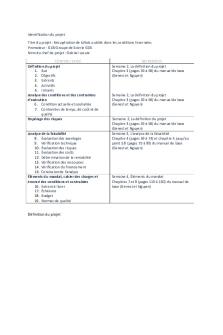
ADM 1450 TP1 - ADM 1450 TP1
- 1 Pages

Chapter 10 quiz #10
- 3 Pages

Notes 10 - Chapter 10
- 5 Pages
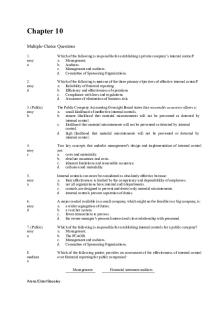
Chapter-10
- 19 Pages
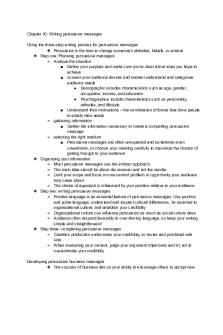
Chapter 10
- 5 Pages

Chapter 10
- 14 Pages

Chapter 10
- 111 Pages
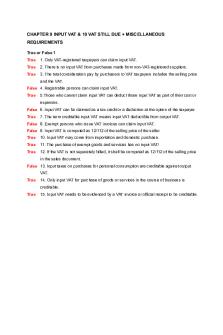
Chapter 10
- 16 Pages

Chapter 10
- 47 Pages
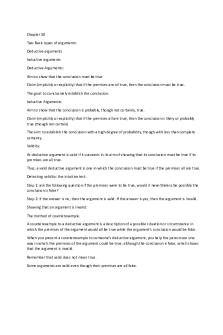
Chapter 10
- 4 Pages
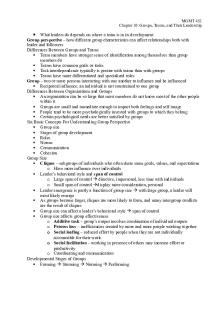
Chapter 10
- 5 Pages
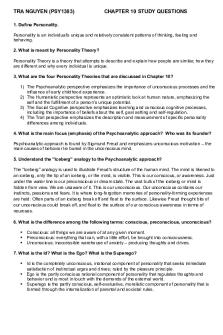
Chapter 10
- 6 Pages
Popular Institutions
- Tinajero National High School - Annex
- Politeknik Caltex Riau
- Yokohama City University
- SGT University
- University of Al-Qadisiyah
- Divine Word College of Vigan
- Techniek College Rotterdam
- Universidade de Santiago
- Universiti Teknologi MARA Cawangan Johor Kampus Pasir Gudang
- Poltekkes Kemenkes Yogyakarta
- Baguio City National High School
- Colegio san marcos
- preparatoria uno
- Centro de Bachillerato Tecnológico Industrial y de Servicios No. 107
- Dalian Maritime University
- Quang Trung Secondary School
- Colegio Tecnológico en Informática
- Corporación Regional de Educación Superior
- Grupo CEDVA
- Dar Al Uloom University
- Centro de Estudios Preuniversitarios de la Universidad Nacional de Ingeniería
- 上智大学
- Aakash International School, Nuna Majara
- San Felipe Neri Catholic School
- Kang Chiao International School - New Taipei City
- Misamis Occidental National High School
- Institución Educativa Escuela Normal Juan Ladrilleros
- Kolehiyo ng Pantukan
- Batanes State College
- Instituto Continental
- Sekolah Menengah Kejuruan Kesehatan Kaltara (Tarakan)
- Colegio de La Inmaculada Concepcion - Cebu
